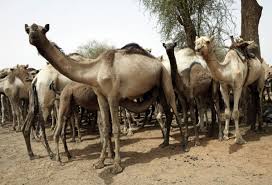Polymorphisms of Tyrosinase gene (Exon 1) and its impact on coat color and phenotypic measurements of Sudanese Camel Breeds
Keywords:
Genotyping, Tyrosinase gene, PCR-RFLP, Sudanese camels, Body measurements, Coat colourAbstract
The objectives of the present study were the detection of allelic variants of tyrosinase (TYR) gene (Exon 1) in six Sudanese camel breeds (Kenani, Lahwee, Rashaidi, Anafi, Bishari and Kabbashi) and afford the chance of investigating the possibility of the presence of associations between coat color and body measurements with SNPs of the TYR gene (Exon 1). The gene and genotypic frequencies of TYR gene in Sudanese camel breeds were studied using PCR-RFLP analyses. Genomic DNA samples were obtained from 181 mature unrelated animals representing the six tested camel breeds. The results showed insignificant differences in the allele frequency between the breeds. Kenani and Anafi camels had slightly higher T allele frequency (0.21 and 0.20) than those of Lahwee, Kabbashi and Bishari camels, while the Rashaidi camel had the lowest T allele frequency (0.08). The genotype frequencies for all breeds obtained were 0.02, 0.25 and 0.72 for TT, TC and CC genotypes respectively. The genotype TT was detected only in Lahwee and Anafi camels. The analysis of variance showed that the age and breed of camel significantly influenced barrel girth, heart girth and body weight, however, the sex of camel significantly affected heart girth, shoulder height and body weight. On the other hand, the TYR genotype was significantly affect shoulder height but had no significant influence on the other tested traits. The results also revealed that insignificant association between camel coat colour and TYR genotypes. Further studies with larger numbers of animals are required in the future to investigate or verify these associations.
References
Boue, A., 1949. Weight Determination in the North African Dromedary. Rev. Elev. Vet. Pays trop., N.S.3: 13-16. In:
Wilson R T (1984). The camel. Longman group limited, Essex, U.K.
Dioli, M., Schwarz, H.J., Stimmelmaryr, R., 1992. Management and handling of the camel. In: Schwarz HJ and M
Dioli, 1992. The one-humped camels (Camelus dromedarius) in Eastern of Africa: A pictorial guide to diseases,
health care and management. Verlag Josef Margraf.
Ishag, I.A., Eisa, M.O., Ahmed, M.K., 2011a. Effect of Breed, Sex and Age on Body Measurements of Sudanese
Camels (Camelus dromedarius). Australian Journal of Basic and Applied Sciences, 5(6), 311-315.
Ishag, I.A., Eisa, M.O., Ahmed, M.K., 2011b. Phenotypic characteristics of Sudanese camels (Camelus dromedarius).
Livestock Research for Rural Development, 23(4). http://www.lrrd.org/lrrd23/4/cont2304.htm.
Ishag, I.A., Reissmann, M., Peters, K.J., Musa, L.M., Ahmed, M.K.A., 2010. Phenotypic and molecular
characterization of six Sudanese camel breeds. South African Journal of Animal Science, 40, 319-326.
Kesseba, A.M., Wardeh, F.M., Wilson, R.T., Zaied, A.A., 1991. Camel Applied Research and Development Network.
Proceedings of International Conference on Camel Production and improvement, 10-13 December, Tobruk,
Libya, 21-36.
Khouri, F., 2000. Camel in Sudan: Ecology, production systems, characterization and herd dynamics. The Camel
Applied Research and Development Network (CARDN). The Arab Center for Studies of Arid Zones and Dry
Land (ACSAD). CARDN/ACSAD/ Camel/ P 96/ 2000. 137 pp.
Mehari, Y., Mekuriaw, Z., Gebru, G., 2007. Potentials of camel production in Babilie and Kebribeyah woredas of the
Jijiga Zone, Somali Region, Ethiopia. Livestock Research for Rural Development, 19 (4).
http://www.lrrd.org/lrrd19/4/meha19058.htm.
Ministry of Animal Resources, 2005. Department of Statistics and Information, Khartoum-Sudan.
Sakr, I., Majid, A.M., 1998. The Social Economics of Camel Herders in Eastern Sudan. The Camel Applied Research
and Development Network/ CARDN/ ACSAD/ p30/ 1-27.
SAS Institute Inc., 2000. Statistical Analysis Software (CD-ROM), Version 8.1, SAS Institute Inc., Cary.
Schmidtz, B.H., Buchanan, F.C., Plante, Y., Schmutz, S.M., 2001. Linkage mapping of tyrosinase gene to bovine
chromosome 26. Anim. Genet, 32, 119-120.
Shah, M.G., 2006. Differentiation of six Pakistani camel breed by phenotype and molecular genetics analysis.
University of Agriculture, Faisalabad, Doctor Thesis.
Shah, M.G., Reissmann, M., Qureshi, A.S., Schwartz, H.J., 2005. Sequencing and mutation screening in exon 1 of
camel tyrosinase gene. The global food & product chain-dynamics, innovations, conflicts, strategies.
Deutscher Tropentag, October 11-13, 2005, Hohenheim.
Shah, M.G., Reissmann, M., Qureshi, A.S., Schwartz, D.H.J., 2008. Evaluation of six camel breeds for heterozygocity
through restriction fragment length polymorphism. Pak Vet J. 28(1), 13-16.
Wardeh, M.F., 2004. Classification of the dromedary camels. J. Camel Sci. 1, 1-7.

Published
How to Cite
Issue
Section
License
Copyright (c) 2013 I. A. Ishag, M. Reissmann, H. A. Eltaher, M.K .A. Ahmed

This work is licensed under a Creative Commons Attribution-NonCommercial-NoDerivatives 4.0 International License.



